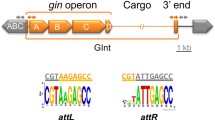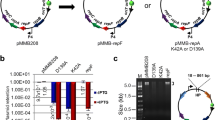Summary
Five different DNA insertions (ISH1, ISH2, ISH23, ISH24, and ISH25) are found in or upstream of the bacterio-opsin (bop) gene in Bop mutants of H. halobium. These insertions have been cloned and characterized. They range in size from 520–3,000 bp, and four of the five insertions have structural features similar to known transposable elements. Two of the elements (ISH1 and ISH2) are found in the majority of Bop mutants. The former integrates at a preferred target site, while the latter integrates at numerous sites. The copy number of each insertion element was determined along with its distribution in the 68% G+C (FI), 58% G+C (FII) and cccDNA fractions of the H. halobium genome. There are eight copies of ISH2, one copy in FI and seven in the cccDNA. There are two copies of each of the other three insertion elements and one copy of ISH25. ISH25 does not seem to have the usual structural features of a transposable element. Most of the copies of these insertion elements are located in the cccDNA. Vacuole, ruberin and purple membrane mutants of H. halobium occur at high spontaneous frequencies. Rearrangements, insertions and deletions occur concurrently in the FII and cccDNA of these mutants including insertions of these five elements. Although the bacterio-opsin gene incurs insertions frequently, the 40 kb of flanking FI DNA remains conserved in mutant derivatives of H. halobium and in a number of related species.
Similar content being viewed by others
References
Betlach M, Pfeifer F, Friedman J, Boyer HW (1983) Bacterio-opsin mutants of Halobacterium halobium. Proc Natl Acad Sci USA 80:1416–1420
Carlos MP, Miller JH (1980) Transposable elements. Cell 20:579–596
DasSarma S, RajBhandary UL, Khorana HG (1983) High frequency spontaneous mutations in the bacterio-opsin gene in Halobacterium halobium are mediated by transposable elements. Proc Natl Acad Sci USA 80:2201–2205
Dunn R, McCoy J, Simsek M, Majumdar A, Chang SH, Raj Bhandary UL, Khorana HG (1981) The bacteriorhodopsin gene. Proc Natl Acad Sci USA 78:6744–6748
Kandler O (ed) (1982) Archaebacteria: Proceedings of the First International Workshop on Archaebacteria, Munich, 1982. Fisher, Stuttgart New York
Kleckner N (1981) Transposable elements in procaryotes. Annu Rev Genet 15:314–404
Moore RL, McCarthy BJ (1969) Characterization of the deoxyribonucleic acid of various strains of halophilic bacteria. J Bacteriol 99:248–254
Mullakhanbhai MF, Larsen H (1975) Halobacterium volcanii spec. nov., a Dead Sea Halobacterium with a moderate salt requirement. Arch Microbiol 104:207–214
Pfeifer F, Weidinger G, Goebel W (1981a) Plasmids in Halobacteria. J Bacteriol 145:369–374
Pfeifer F, Weidinger G, Goebel W (1981b) Genetic variability in Halobacterium halobium. J Bacteriol 145:375–381
Pfeifer F, Ebert K, Weidinger G, Goebel W (1982) Structure and function of chromosomal and extrachromosomal DNA in Halobacteria. Zentralbl Bakt Hyg I. Abt Orig C 3,110–119
Rigby PWF, Dieckman M, Rhodes C, Berg P (1977) Labelling deoxyribonucleic acid to high specific activity in vitro by nicktranslation with DNA polymerase I. J Mol Biol 113:237–251
Sapienza C, Doolittle WF (1982) Unusual physical organization of the Halobacterium genome. Nature (London) 295:384–389
Sapienza C, Rose MR, Doolittle WF (1982) High frequency genomic rearrangements involving archaebacterial repeat sequence elements. Nature (London) 299:182–185
Simsek M, DasSarma S, RajBhandary UL, Khorana HG (1982) A transposable element from Halobacterium halobium which inactivates the bacteriorhodopsin gene. Proc Natl Acad Sci USA 79:7268–7272
Southern EM (1975) Detection of specific sequences among DNA fragments separated by gel electrophoresis. J Mol Biol 98:503–517
Spudich EN, Spudich JL (1982) Control of transmembrane ion fluxes to select halorhodopsin-deficient and other energy-transduction mutants of Halobacterium halobium. Proc Natl Acad Sci USA 79:4308–4312
Stoeckenius W, Bogomolni RA (1982) Bacteriorhodopsin and related pigments of Halobacteria. Annu Rev Biochem 52:587–616
Weber HJ, Bogomolni RA (1981) P558, A second retinal containing pigment in Halobacterium halobium. Photochem Photobiol 33:601–608
Weidinger G, Klotz G, Goebel W (1979) A large plasmid from Halobacterium halobium carrying genetic information for gas vacuole formation. Plasmid 2:377–386
Weidinger G (1980) Biochemische und genetische Charakterisierung eines Plasmids aus Halobacterium halobium. Dissertation, Universität Würzburg
Author information
Authors and Affiliations
Additional information
Communicated by W. Arber
Rights and permissions
About this article
Cite this article
Pfeifer, F., Betlach, M., Martienssen, R. et al. Transposable elements of Halobacterium halobium . Mol Gen Genet 191, 182–188 (1983). https://doi.org/10.1007/BF00334811
Received:
Issue Date:
DOI: https://doi.org/10.1007/BF00334811




